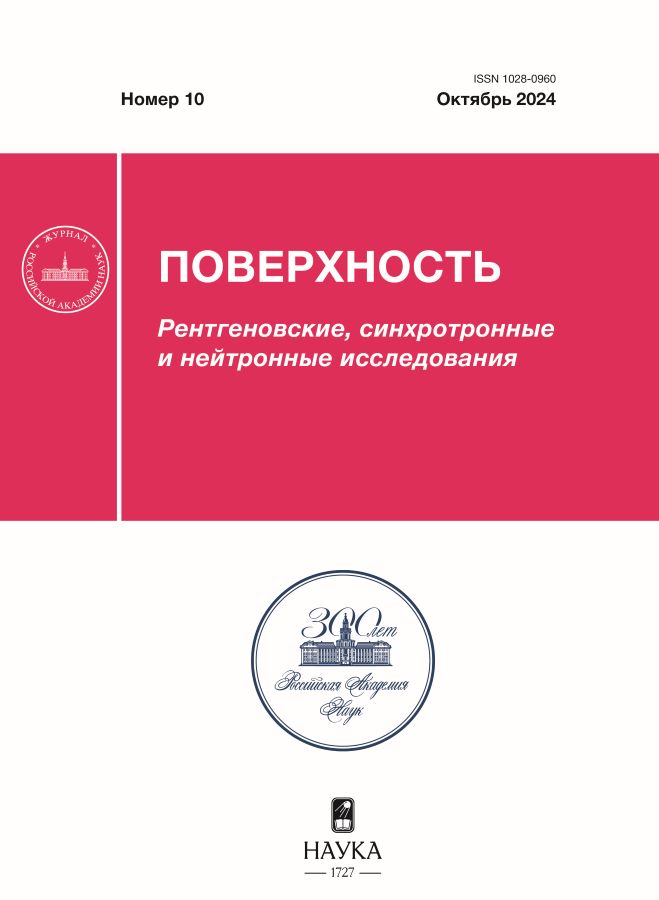Structural changes of the K-208 glass surface after proton irradiation of different intensity
- 作者: Khasanshin R.H.1,2, Novikov L.S.3
-
隶属关系:
- Joint Stock Company “Composite”
- Bauman Moscow State Technical University
- Lomonosov Moscow State University
- 期: 编号 10 (2024)
- 页面: 24-30
- 栏目: Articles
- URL: https://freezetech.ru/1028-0960/article/view/664730
- DOI: https://doi.org/10.31857/S1028096024100041
- EDN: https://elibrary.ru/SHOYHB
- ID: 664730
如何引用文章
详细
Changes in the structure of the surface of K-208 glass irradiated in vacuum (10–4 Pa) by protons with energies of 30 keV have been studied. It has been established that the nature of the changes depends on the proton flux density (ϕр). At ϕр < 3.0 × 1010 cm–2·s–1, the changes are mainly associated with the emergence of percolation channels on the irradiated surface. Percolation channels during proton irradiation of glass are formed as a result of migration of Na+ ions in the field of the charge injected into the glass. As ϕр increases, the formation of gas-filled bubbles begins to play a significant role. The appearance of bubbles is due to the fact that the field migration of Na+ ions is accompanied by the release of non-bridge oxygen atoms, which provided electrical neutrality in the vicinity of the localization of these ions. At values of ϕ > 2 × 1011 cm–2·c–1, gas-filled bubbles and sodium microarrays form and grow in pairs. The authors believe that under these irradiation conditions, accelerated field migration of sodium ions through the percolation channel ensures intensive release of non-bridge oxygen atoms in its vicinity, followed by their migration and the formation of gas-filled bubbles.
全文:
作者简介
R. Khasanshin
Joint Stock Company “Composite”; Bauman Moscow State Technical University
编辑信件的主要联系方式.
Email: rhkhas@mail.ru
俄罗斯联邦, Korolev, Moscow region; Moscow
L. Novikov
Lomonosov Moscow State University
Email: rhkhas@mail.ru
Skobeltsyn Institute of Nuclear Physics
俄罗斯联邦, Moscow参考
- Messenger S.R., Wong F., Hoang B., Cress C.D., Walters R.J., Kleuver C.A., Jones G. // IEEE Trans. Nucl. Sci. 2014. V. 61. № 6. P. 3348. https://www.doi.org/10.1109/TNS.2014.2364894.
- Toyoda K., Okumura T., Hosoda S., Cho M. // J. Spacecraft Rockets. 2005. V. 42. № 5. P. 947. https://www.doi.org/10.2514/1.116022
- Ferguson D.C., Wimberly S.C. The Best GEO Daytime Spacecraft Charging Index. // Proc. 50th AIAA Aerospace Sci. Mtg. January, 2013. P. AIAA 2013-0810. https://www.doi.org/10.2514/6.2013-810
- Модель космоса. Научно-информационное издание. Т. 2. / Ред. Новикова Л.С. М.: КДУ, 2007, 1144 с.
- Xinjie F., Lixin S., Jiacheng L. // J. Rare Earths. 2014. V. 32. P. 1037. https://www.doi.org/10.1016/S1002-0721(14)60180-0
- Kadono K., Itakura N., Akai T., Yamashita M., Yazawa T. // J. Phys.: Condensed Matter. 2010. V. 22. P. 045901. https://www.doi.org/10.1088/0953-8984/22/4/045901
- Kreidl N., Hensler J. // J. Am. Ceramic Soc. 2006. V. 38. P. 423. https://www.doi.org/10.1111/j.1151-2916.1955.tb14568.x
- Gedeon O., Hulinsky V., Jurek K. // Mikrochimica Acta. 2000. V. 132. № 2–4. P. 505. https://doi.org/10.1007/s006040050050
- Khasanshin R.H., Novikov L.S. // Adv. Space Res. 2016. V. 57. P. 2187. https://www.doi.org/10.1016/j.asr.2016.02.023
- Khasanshin H.R., Novikov S.L. // IEEE Transactions on Plasma Science. 2019. V.47, No 8. P. 3796-3800. https://www.doi.org/10.1109/TPS.2019.2916210
- Gavenda T., Gedeon O., Jurek K. // Nucl. Instrum. Methods. Phys. Res. B. 2014 V. 322. P. 7. https://www.doi.org/10.1016/j.nimb.2013.12.017
- Hanna R., Paulmier T., Belhaj M., Molinie P., Dirassen B., Payan D, Balcon N. // J. Appl. Phys. D. 2011. V. 44 P. 445402. https://www.doi.org/10.1088/0022-3727/44/44/445402
- Guerch K., Paulmier T., Guillemet-Fritsch S., Lenormand P. // Nucl. Instrum. Methods B. 2015. V. 349. P. 147. https://www.doi.org/10.1016/j.nimb.2015.02.046.
- Ковивчак В.С., Панова Т.В. // Поверхность. Рентген., синхротр. и нейтрон. исслед. 2017. № 8. С. 59. https://www.doi.org/10.7868/S020735281708008X
- Fakhfakh S., Jbara O., Belhaj M., Rondot S. // J. Appl. Phys. 2008. V. 104. P. 093704. https://www.doi.org/10.1063/1.3006012
- Ковивчак В.С., Попов В.Е., Панова Т.К., Бурлаков Р.Б. // Поверхность. Рентген., синхротр. и нейтрон. исслед. 2003. № 4. С. 38.
- Хасаншин Р.Х., Новиков Л.С., Коровин С.Б. // Поверхность. Рентген., синхротрон. и нейтрон. исслед. 2017. № 9. С. 28. https://www.doi.org/10.7868/S0207352817090049
- Хасаншин Р.Х., Новиков Л.С. // Поверхность. Рентген., синхротрон. и нейтрон. исслед., 2018. № 11. С. 48. https://www.doi.org/10.1134/S0207352818110136
- Čermák J., Mihai L., Sporea D., Galagan Y., Fait J., Artemenko A., Štenclov P. Rezek B., Straticiuc M., Burducea I. // Solar Energy Materials and Solar Cells. 2018. V. 186. P. 284. https://www.doi.org/10.1016/j.solmat.2018.06.046
- Zhang Z., Yang W. // Opt. Mater. Express. 2017. V. 7. P. 3979. https://www.doi.org/10.1364/OME.7.003979
- Jensen T., Lawn B.R., Dalglish R.L., Kelly J.C. // Radiation Effects: Incorporating Plasma Science and Plasma Technology. 1976. V. 28. Iss. 3–4. P. 245. https://www.doi.org/10.1080/00337577608237446
- Хасаншин Р.Х., Применко Д.А. // Изв. РАН. Серия физическая. 2022. Т. 86. № 5. C. 633. https://www.doi.org/10.31857/S036767652205009X
- Colthup N.B., Daly L.H., Wiberley S.E. Introduction to Infrared and Raman Spectroscopy. 3d ed. L.: Academic Press, 1990. 547 p.
- Abbas A., Serruys Y., Ghaleb D., Delaye J., Boizot B., Reynard B., Calas G. // Nucl. Instrum. Methods B. 2000. V. 166–167. P. 445. https://www.doi.org/10.1016/S0168-583X(99)00695-3
- Zhang G.F., Wang T.S., Yang K.J., Chen L., Zhang L.M., Peng H.B., Yuan W., Tian F. // Nucl. Instrum. Methods B. 2013. V. 316. P. 218. https://www.doi.org/10.1016/j.nimb.2013.09.020
- Chen L., Zhang D.F., Lv P., Zhang J., Du X., Yuan W., Nan Sh. Zhu Z., Wang T.S. // J. Non-Crystalline Solids. 2016. V. 448. P. 6. https://www.doi.org/10.1016/j.jnobcrysol.2016.06.029
- Chen L., Wang T.S., Yang K.J., Peng H.B., Zhang G.F., Zhang L.M., Jiang H., Wang Q. // Nucl. Instrum. Methods B. 2013. V. 307. P. 566. https://www.doi.org/10.1016/j.nimb.2013.01.089
- Хасаншин Р.Х., Новиков Л.С. // Поверхность. Рентген., синхротрон. и нейтрон. исслед. 2021. № 7. С. 30. https://www.doi.org/10.31857/S1028096021070086
补充文件















